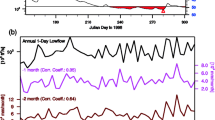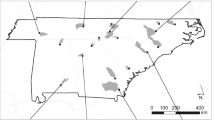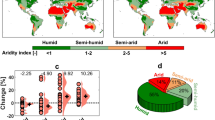Abstract
It is firmly established in the hydrologic literature that flooding depends on both antecedent watershed wetness and precipitation. One could phrase this relationship as “heavy precipitation does not necessarily lead to high stream discharge”, but rarely do studies directly affirm this statement. We have observed several non-hydrologists mistake trends in heavy precipitation as a proxy for trends in riverine flooding. If the relationship between heavy precipitation and high discharge was more often explicitly presented, heavy precipitation may less often be misinterpreted as a proxy for discharge. In this paper, we undertake such an analysis for 390 watersheds across the contiguous U.S. We found that 99th percentile precipitation only results in 99th percentage discharge 36 % of the time. However, when conditioned on soil moisture from the Variable Infiltration Capacity model, 62 % of 99th percentile precipitation results in 99th percentile discharge during wet periods and only 13 % during dry periods. When relating trends in heavy precipitation to hydrologic response, precipitation data should, therefore, be segregated based on concurrent soil moisture. Taking this approach for climate predictions, we found that CMIP-5 atmosphere–ocean global circulation model (AOGCM) simulations for a RCP 6.0 forcing project increases in concurrence of greater than median soil wetness and extreme precipitation in the northern United States and a decrease in the south, suggesting northern regions could see an increase in very high discharges while southern regions could see decreases despite both regions having an increase in extreme precipitation. While the actual outcome is speculative given the uncertainties of the AOGCM’s, such an analysis provides a more sophisticated framework from which to evaluate the output as well as historic climate data.




Similar content being viewed by others
References
Berthet L, Andreassian V, Perrin C, Javelle P (2009) How crucial is it to account for antecedent moisture conditions in flood forecasting? Comparison of event-based on continuous approaches on 178 catchments. Hydrol Earth Syst Sci 13:819–831
DeGaetano AT (2009) Time-dependent changes in extreme-precipitation return-period amounts in the continental United States. J Appl Meteorol Climatol 48:2086–2099. doi:10.1175/2009JAMC2179.1
Dirmeyer PA, Fang G, Wang Z, Yadav P, Milton A (2014) Climate change and sectors of the surface water cycle in CMIP5 projections. Hydrol Earth Syst Sci 18:5317–5329. doi:10.5194/hess-18-5317-2014
Douglas EM, Vogel RM, Kroll CN (2000) Trends in floods and low flows in the United States: impact of spatial correlation. J Hydrol 240:90–105. doi:10.1016/S0022-1694(00)00336-X
Duan Q et al (2006) Model parameter estimation experiment (MOPEX): an overview of science strategy and major results from the second and third workshops. J Hydrol 320:3–17. doi:10.1016/j.jhydrol.2005.07.031
Dunkerley D (2012) Effects of rainfall intensity fluctuation on infiltration and runoff: rainfall simulation on dryland soils, Fowlers Gap, Australia. Hydrol Process 26:2211–2224. doi:10.1002/hyp.8371
Georgakakos A et al (2014) Ch. 3: Water Resources. Climate Change Impacts in the United States: The Third National Climate Assessment, U.S. Global Change Research Program, 69–112, doi:10.7930/J0G44N6T
Groisman PY, Knight RW, Karl TR (2001) Heavy precipitation and high streamflow in the contiguous United States: trends in the twentieth century. Bull Am Meteorol Soc 82:219–246. doi:10.1175/1520-0477(2001)082<0219:HPAHSI>2.3.CO;2
Groisman PY, Knight RW, Karl TR (2012) Changes in intense precipitation over the central United States. J Hydrometeorol 13:47–66. doi:10.1175/JHM-D-11-039.1
Hirsch RM, Ryberg KR (2012) Has the magnitude of floods across the USA changed with global CO2 levels? Hydrol Sci J 57(1):1–9. doi:10.1080/02626667.2011.621895
Karl TR, Knight RW (1998) Secular trends of precipitation amount, frequency, and intensity in the United States. Bull Am Meteorol Soc 79:231–241. doi:10.1175/1520-0477(1998)079<0231:STOPAF>2.0.CO;2
Koirala S, Hirabayashi Y, Mahendran R, Kanae S (2014) Global assessment of agreement among streamflow projections using CMIP5 model outputs. Environ Res Lett 9(2014):064017. doi:10.1088/1748-9326/9/6/064017
Latifovic R et al (2002) Landcover of North America 2000. Natural Resources Canada, Canada Center for Remote Sensing, US Geological Service EROS Data Center
Li H, Luo L, Wood EF, Schaake J (2009) The role of initial conditions and forcing uncertainties in seasonal hydrologic forecasting. J Geophys Res 114:D04114
Lins HF, Cohn TA (2011) Stationarity: wanted dead or alive? J Am Water Resour Assoc 47:475–480
Mallakpour I, Villarini G (2015) The changing nature of flooding across the central United States. Nat Clim Chang 2:250–254
Massari C, Brocca L, Moramarco T, Tramblay Y, Didon-Lescot JD (2014) Potential of soil moisture observations in flood modelling: estimating initial conditions and correcting rainfall. Adv Water Resour 74:44–53
Maurer EP, Wood AW, Adam JC, Lettenmaier DP, Nijssen B (2002) A long-term hydrologically-based data set of land surface fluxes and states for the conterminous United States. J Clim 15:3237–3251. doi:10.1175/1520-0442(2002)015<3237:ALTHBD>2.0.CO;2
Radatz TF, Thompson AM, Madison FW (2013) Soil moisture and rainfall intensity thresholds for runoff generation in southwestern Wisconsin agricultural watersheds. Hydrol Process 27:3521–3534. doi:10.1002/hyp.9460
Shaw SB, Riha SJ (2011) Assessing possible changes in flood frequency due to climate change in mid-sized watersheds in New York State, USA. Hydrol Process 25:2542–2550. doi:10.1002/hyp.8027
Small D, Islam S, Vogel RM (2006) Trends in precipitation and streamflow in the eastern U.S.: paradox or perception? Geophys Res Lett 33:L03403. doi:10.1029/2005GL024995
Smith JA et al (2013) Extreme flood response: the June 2008 flooding in Iowa. J Hydrometeorol 14:110–1825
Tramblay Y, Bouvier C, Martin C, Didon-Lescot J-F, Todorovik D, Domergue J-M (2010) Assessment of initial soil moisture conditions for event-based rainfall-runoff modeling. J Hydrol 387:176–187
Van Steenbergen N, Willems P (2013) Increasing river preparedness by real-time warning based on wetness state conditions. J Hydrol 489:227–237. doi:10.1016/j.jhydrol.2013.03.015
Villarini G, Smith JA (2010) Flood peak distributions for the eastern United States. Water Resour Res 46:W06504
Vogel RM, Yaindl C, Walter M (2011) Nonstationarity: flood magnification and recurrence reduction factors in the United States. J Am Water Resour Assoc 47:464–474
Walsh J et al (2014) Ch. 2: Our Changing Climate. Climate Change Impacts in the United States: The Third National Climate Assessment. In: Melillo J M, Terese T C, Richmond, Yohe G W (eds) U.S. Global Change Research Program, 19–67, doi:10.7930/J0KW5CXT
Acknowledgments
We acknowledge the World Climate Research Programme’s Working Group on Coupled Modelling, which is responsible for CMIP 5, and we thank the climate modeling groups for producing and making available their model output at http://pcmdi9.llnl.gov/esgf-web-fe. We also acknowledge NOAA’s National Weather Services’ Hydrologic Modeling division which is responsible for the MOPEX project. These data are available at ftp://hydrology.nws.noaa.gov/pub/gcip/mopex/US_Data/Us_438_Daily/. Finally we acknowledge the University of Washington VIC group who provided the soil moisture data available at http://jisao.washington.edu/data/vic/.
Author information
Authors and Affiliations
Corresponding author
Rights and permissions
About this article
Cite this article
Ivancic, T.J., Shaw, S.B. Examining why trends in very heavy precipitation should not be mistaken for trends in very high river discharge. Climatic Change 133, 681–693 (2015). https://doi.org/10.1007/s10584-015-1476-1
Received:
Accepted:
Published:
Issue Date:
DOI: https://doi.org/10.1007/s10584-015-1476-1




